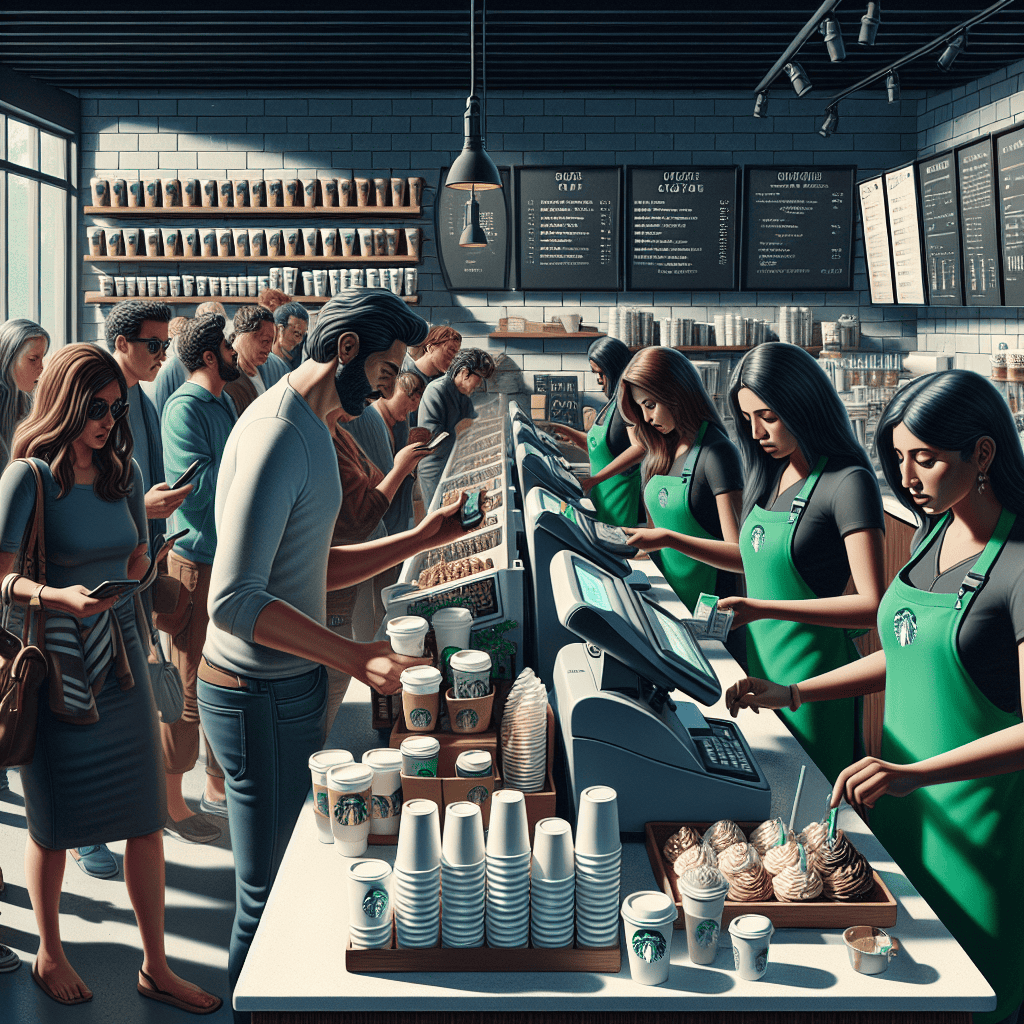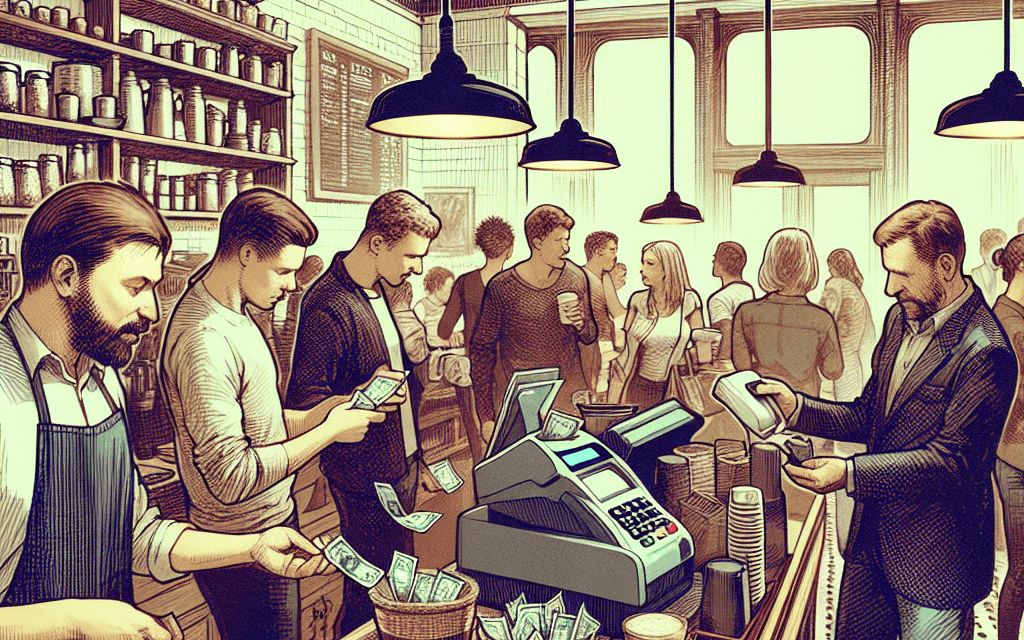-
Table of Contents
- Introduction
- Impact Of Technology Glitches On Retail Operations
- Starbucks’ Contingency Plans For Payment System Failures
- Customer Reactions To Starbucks’ Temporary Cash-Only Policy
- Lessons Learned From Starbucks’ Tech Glitch Incident
- The Role Of Cash In A Digital Payment World
- How Starbucks Managed Customer Experience During The Glitch
- The Importance Of Backup Systems In Retail Technology
- Analyzing The Financial Implications Of Payment System Outages
- Starbucks’ Communication Strategy During The Tech Glitch
- Future-Proofing Retail Payment Systems Against Glitches
- Q&A
- Conclusion
“Brewing Simplicity: Starbucks Goes Back to Cash Basics!”
Introduction
In a surprising turn of events, Starbucks, the global coffeehouse chain renowned for its seamless digital payment systems, recently faced a significant technological glitch that forced the company to revert to cash transactions. This unexpected disruption highlighted the challenges even the most technologically advanced companies can encounter. As digital payments have become increasingly integral to the customer experience, the temporary shift back to cash payments underscored the importance of maintaining robust contingency plans. The incident not only tested Starbucks’ operational resilience but also served as a reminder of the delicate balance between innovation and reliability in the fast-paced world of retail technology.
Impact Of Technology Glitches On Retail Operations
In the fast-paced world of retail, technology serves as the backbone of operations, streamlining processes and enhancing customer experiences. However, when technology falters, the repercussions can be significant, as evidenced by a recent incident involving Starbucks. The global coffee giant, renowned for its seamless integration of technology in its operations, faced an unexpected challenge when a widespread tech glitch forced it to revert to cash transactions. This incident underscores the profound impact that technology glitches can have on retail operations, highlighting both vulnerabilities and the need for robust contingency plans.
The reliance on technology in retail is undeniable, with point-of-sale systems, mobile payment options, and digital loyalty programs becoming integral components of the customer experience. For Starbucks, a company that prides itself on innovation, the integration of technology is not just about efficiency but also about enhancing customer engagement. Mobile ordering and payment systems have become a hallmark of the Starbucks experience, allowing customers to order and pay with ease. However, the recent tech glitch disrupted this seamless experience, compelling the company to temporarily abandon its digital systems in favor of cash transactions.
This unexpected shift to cash-only operations had immediate implications for both customers and employees. For customers accustomed to the convenience of digital payments, the sudden change was a source of frustration. Long queues formed as baristas manually processed transactions, leading to delays and dissatisfaction. For employees, the glitch added an extra layer of complexity to their roles, requiring them to adapt quickly to a manual system that many had not used extensively. This situation highlights the critical role that training and preparedness play in mitigating the impact of technology failures.
Moreover, the incident at Starbucks serves as a reminder of the broader vulnerabilities inherent in retail operations heavily reliant on technology. While digital systems offer numerous advantages, they also introduce potential points of failure. A single glitch can cascade through an entire operation, affecting everything from inventory management to customer service. This underscores the importance of having robust backup systems and contingency plans in place. Retailers must anticipate potential disruptions and develop strategies to maintain operations and customer satisfaction in the face of technological challenges.
In addition to operational disruptions, technology glitches can also have financial implications. For Starbucks, the inability to process digital payments likely resulted in lost sales, as some customers may have opted to forego their purchases rather than deal with the inconvenience of cash transactions. This highlights the need for retailers to assess the financial risks associated with technology failures and to implement measures to mitigate these risks. Insurance policies, reserve funds, and strategic partnerships can all play a role in cushioning the financial impact of such incidents.
Furthermore, the Starbucks incident underscores the importance of communication in managing technology-related disruptions. Clear and timely communication with customers is essential to maintaining trust and minimizing frustration. In this case, Starbucks utilized social media and in-store signage to inform customers of the issue and to provide updates on the resolution process. This proactive approach helped to manage customer expectations and demonstrated the company’s commitment to transparency.
In conclusion, the recent tech glitch at Starbucks serves as a poignant reminder of the critical role that technology plays in retail operations and the potential vulnerabilities it introduces. As retailers continue to embrace digital solutions, they must also prioritize the development of robust contingency plans, effective communication strategies, and comprehensive training programs. By doing so, they can better navigate the challenges posed by technology glitches and ensure a seamless experience for both customers and employees.
Starbucks’ Contingency Plans For Payment System Failures
In an unexpected turn of events, Starbucks recently faced a significant technological glitch that disrupted its digital payment systems across numerous locations. This unforeseen issue compelled the global coffee giant to revert to cash transactions, a move that highlighted the importance of having robust contingency plans for payment system failures. As technology continues to evolve and integrate into everyday business operations, the reliance on digital payment systems has become increasingly prevalent. However, this incident serves as a reminder of the vulnerabilities inherent in such systems and the necessity for businesses to prepare for potential disruptions.
The glitch, which affected both the Starbucks app and in-store card readers, left many customers unable to use their preferred digital payment methods. Consequently, Starbucks had to quickly adapt by accepting cash payments, a practice that has become less common in recent years due to the convenience and speed of digital transactions. This shift not only tested the company’s operational flexibility but also underscored the importance of maintaining traditional payment methods as a backup.
In response to the situation, Starbucks implemented a series of measures to mitigate the impact on both customers and employees. Staff were trained to handle cash transactions efficiently, ensuring that service remained as seamless as possible despite the challenges. Additionally, Starbucks communicated transparently with its customers, providing updates on the status of the issue and reassuring them that efforts were underway to resolve the problem swiftly. This approach helped to maintain customer trust and loyalty, even in the face of inconvenience.
Moreover, the incident prompted Starbucks to reevaluate its existing contingency plans and explore ways to enhance its resilience against future technological disruptions. This includes investing in more robust IT infrastructure, conducting regular system audits, and developing comprehensive response strategies that can be swiftly activated in the event of a similar occurrence. By doing so, Starbucks aims to minimize the risk of prolonged service interruptions and ensure that its operations can continue smoothly, regardless of technological challenges.
Furthermore, this situation has broader implications for the retail industry as a whole. As businesses increasingly rely on digital payment systems, the potential for technical failures becomes a critical concern. Companies must recognize the importance of having contingency plans in place, not only to address immediate operational challenges but also to safeguard their reputation and customer relationships. This involves a multifaceted approach that includes employee training, customer communication strategies, and investment in technology that can withstand unexpected disruptions.
In conclusion, Starbucks’ recent experience with a payment system glitch serves as a valuable lesson for businesses worldwide. It highlights the necessity of being prepared for technological failures and the importance of maintaining traditional payment methods as a viable alternative. By learning from this incident and strengthening their contingency plans, companies can better navigate the complexities of an increasingly digital landscape. Ultimately, the ability to adapt and respond effectively to unforeseen challenges will be a defining factor in maintaining customer satisfaction and ensuring long-term success in the ever-evolving retail environment.
Customer Reactions To Starbucks’ Temporary Cash-Only Policy
In a surprising turn of events, Starbucks recently faced a significant technological glitch that forced the global coffee giant to temporarily revert to a cash-only policy. This unexpected shift in payment methods has elicited a wide range of reactions from customers, highlighting both the challenges and opportunities that arise when technology falters in a highly digitalized world. As Starbucks patrons navigated this temporary inconvenience, their responses varied, reflecting diverse perspectives on the reliance on technology in everyday transactions.
Initially, many customers expressed frustration at the sudden change, as the convenience of digital payments has become an integral part of their daily routines. For regular patrons accustomed to the seamless experience of using mobile apps and credit cards, the cash-only policy posed an unexpected hurdle. Some customers found themselves unprepared, having to scramble to find cash or visit ATMs, which added an extra layer of inconvenience to their coffee runs. This disruption underscored the extent to which digital payment systems have become embedded in consumer habits, with many individuals no longer carrying cash as a matter of course.
However, amid the initial frustration, some customers viewed the situation as a nostalgic throwback to simpler times. For those who remember a pre-digital era, the cash-only policy evoked a sense of nostalgia, reminding them of a time when cash transactions were the norm. This perspective was particularly prevalent among older customers, who appreciated the opportunity to engage in a more traditional form of commerce, albeit temporarily. This sentiment highlights the generational divide in attitudes towards technology, with older individuals often more comfortable with cash transactions than their younger counterparts.
Moreover, the temporary shift to cash payments also sparked conversations about the broader implications of a cashless society. Some customers expressed concerns about the increasing reliance on digital payment systems, pointing out the vulnerabilities that can arise when technology fails. The Starbucks glitch served as a reminder of the potential risks associated with a fully digital economy, prompting discussions about the need for businesses to maintain robust contingency plans to ensure continuity in the face of technological disruptions. This incident has reignited debates about the balance between convenience and security in financial transactions, with some advocating for a more cautious approach to the adoption of cashless systems.
In addition to these broader reflections, the cash-only policy also provided an opportunity for Starbucks to demonstrate its commitment to customer service. The company responded swiftly to the glitch, ensuring that staff were well-prepared to handle the situation and assist customers with the transition. Many patrons appreciated the efforts of Starbucks employees, who remained courteous and efficient despite the challenges posed by the sudden change. This positive customer service experience helped to mitigate some of the frustration associated with the glitch, reinforcing Starbucks’ reputation as a customer-centric brand.
In conclusion, Starbucks’ temporary cash-only policy, prompted by a technological glitch, elicited a wide range of reactions from customers. While some expressed frustration at the inconvenience, others viewed it as a nostalgic return to simpler times. The incident also sparked important conversations about the implications of a cashless society and highlighted the importance of robust contingency plans for businesses. Ultimately, Starbucks’ swift response and commitment to customer service helped to navigate this unexpected challenge, demonstrating the resilience and adaptability of both the company and its patrons in the face of technological disruptions.
Lessons Learned From Starbucks’ Tech Glitch Incident
In a world increasingly reliant on digital transactions, the recent technological hiccup at Starbucks serves as a poignant reminder of the vulnerabilities inherent in our dependence on technology. The coffee giant, known for its seamless integration of digital payment systems, faced an unexpected challenge when a tech glitch forced it to revert to cash-only transactions. This incident not only disrupted the daily operations of one of the world’s most recognized brands but also highlighted several critical lessons for businesses navigating the digital landscape.
Firstly, the Starbucks incident underscores the importance of having robust contingency plans in place. In an era where digital payments have become the norm, businesses must anticipate potential disruptions and prepare accordingly. Starbucks’ ability to quickly pivot to cash transactions, although not without its challenges, demonstrated a level of preparedness that mitigated the impact of the glitch. This adaptability is crucial for any business that relies heavily on technology, as it ensures continuity in the face of unforeseen technical failures.
Moreover, the incident highlights the need for regular system audits and updates. As technology evolves, so too do the potential vulnerabilities that can be exploited or that may arise from system malfunctions. By conducting frequent audits and keeping systems up-to-date, businesses can identify and address potential weaknesses before they lead to significant disruptions. Starbucks’ experience serves as a cautionary tale, emphasizing that even the most sophisticated systems are not immune to failure and that proactive maintenance is essential.
In addition to technical preparedness, the Starbucks glitch also brings to light the importance of effective communication during a crisis. The company’s swift acknowledgment of the issue and transparent communication with customers helped to maintain trust and minimize frustration. This approach is a valuable lesson for businesses, illustrating that clear and honest communication can significantly influence customer perception and loyalty, even in challenging situations.
Furthermore, the incident raises questions about the balance between technological innovation and traditional methods. While digital payment systems offer convenience and efficiency, the Starbucks glitch reminds us of the enduring relevance of cash transactions. Businesses should consider maintaining a balance between embracing new technologies and preserving traditional methods to ensure resilience against technological disruptions. This dual approach can provide a safety net, allowing operations to continue smoothly when digital systems falter.
Additionally, the Starbucks incident serves as a reminder of the broader implications of technological failures on customer experience. In a competitive market, where customer satisfaction is paramount, any disruption can have lasting effects on brand reputation. Businesses must prioritize not only the functionality of their systems but also the overall customer experience, ensuring that any potential disruptions are handled with minimal inconvenience to the consumer.
In conclusion, the tech glitch at Starbucks offers valuable insights into the complexities of operating in a digital world. It highlights the necessity of contingency planning, regular system maintenance, effective crisis communication, and the balance between innovation and tradition. As businesses continue to navigate the ever-evolving technological landscape, these lessons from Starbucks’ experience serve as a guide for building resilience and maintaining customer trust in the face of unexpected challenges. By learning from such incidents, companies can better prepare for the future, ensuring that they remain agile and responsive in an increasingly digital age.
The Role Of Cash In A Digital Payment World

In an era where digital payments have become the norm, the recent decision by Starbucks to revert to cash transactions due to a technological glitch has sparked a renewed conversation about the role of cash in our increasingly digital world. As consumers and businesses alike have embraced the convenience and speed of digital payments, this incident serves as a reminder of the vulnerabilities inherent in a system that relies heavily on technology.
The reliance on digital payment systems has grown exponentially over the past decade, with consumers enjoying the ease of transactions through credit cards, mobile payment apps, and contactless methods. These systems offer numerous advantages, including enhanced security features, the ability to track spending, and the elimination of the need to carry physical currency. However, the Starbucks incident highlights a critical aspect of digital payments: their dependence on technology and the potential for disruptions.
When Starbucks experienced a technical glitch that rendered its digital payment systems inoperable, the company had to quickly adapt by accepting cash transactions. This shift not only underscored the importance of having a backup plan but also highlighted the enduring relevance of cash in a digital economy. While digital payments are often seen as the future, cash remains a reliable and universally accepted form of payment that does not rely on technology or connectivity.
Moreover, the incident at Starbucks brings to light the broader implications for businesses that have moved towards cashless operations. While going cashless can streamline operations and reduce the risk of theft, it also leaves businesses vulnerable to technological failures. In such scenarios, the ability to accept cash can serve as a crucial contingency plan, ensuring that operations can continue smoothly even when digital systems falter.
Furthermore, the reliance on digital payments raises questions about inclusivity and accessibility. Not all consumers have access to digital payment methods, whether due to lack of technology, financial constraints, or personal preference. By maintaining the option to pay with cash, businesses can ensure that they remain accessible to all customers, thereby fostering inclusivity and accommodating diverse consumer needs.
In addition to these practical considerations, the Starbucks incident also prompts a reflection on the psychological and cultural aspects of cash. For many, cash represents a tangible connection to their finances, offering a sense of control and awareness that digital transactions may not provide. The physical act of handing over cash can serve as a powerful reminder of spending, potentially encouraging more mindful financial habits.
As we navigate an increasingly digital world, the Starbucks glitch serves as a timely reminder of the need for balance between embracing technological advancements and maintaining traditional methods. While digital payments offer undeniable benefits, the continued acceptance of cash ensures resilience in the face of technological disruptions and inclusivity for all consumers.
In conclusion, the Starbucks incident underscores the importance of cash as a vital component of the payment ecosystem. As businesses and consumers continue to navigate the complexities of a digital payment world, it is essential to recognize the enduring value of cash. By doing so, we can ensure that our payment systems remain robust, inclusive, and adaptable to the challenges of an ever-evolving technological landscape.
How Starbucks Managed Customer Experience During The Glitch
In an unexpected turn of events, Starbucks recently faced a significant technological glitch that disrupted its digital payment systems, compelling the global coffee giant to revert to cash transactions temporarily. This unforeseen challenge tested the company’s ability to manage customer experience effectively, highlighting the importance of adaptability and communication in maintaining customer satisfaction.
The incident unfolded when Starbucks’ digital payment systems, including mobile app payments and credit card transactions, experienced a widespread outage. This disruption posed a considerable challenge, given that a substantial portion of Starbucks’ transactions are conducted through digital means. In response, Starbucks swiftly transitioned to cash-only transactions, a move that required prompt coordination and clear communication across its extensive network of stores.
To manage the situation, Starbucks prioritized transparent communication with its customers. The company promptly informed patrons of the issue through various channels, including social media platforms and in-store announcements. By keeping customers informed, Starbucks aimed to mitigate frustration and maintain trust, ensuring that patrons were aware of the temporary inconvenience and the steps being taken to resolve it.
Moreover, Starbucks leveraged its well-trained staff to manage the increased demand for cash transactions. Baristas and store managers were briefed on the situation and equipped with strategies to handle customer inquiries and concerns effectively. This proactive approach helped maintain a smooth flow of operations, even as the company navigated the challenges of a cash-only system. Employees were encouraged to exhibit patience and empathy, recognizing that the glitch was an inconvenience for both customers and staff alike.
In addition to effective communication and staff preparedness, Starbucks also focused on minimizing the impact of the glitch on customer experience. The company implemented measures to expedite cash transactions, such as opening additional registers and streamlining the payment process. By doing so, Starbucks aimed to reduce wait times and ensure that customers could continue to enjoy their favorite beverages with minimal disruption.
Furthermore, Starbucks took the opportunity to reinforce its commitment to customer satisfaction by offering incentives to affected customers. Some stores provided complimentary beverages or discounts as a gesture of goodwill, acknowledging the inconvenience caused by the technical difficulties. This approach not only helped to appease frustrated customers but also reinforced Starbucks’ reputation as a customer-centric brand.
As the company worked diligently to resolve the technical glitch, Starbucks’ IT teams collaborated with external partners to identify and rectify the root cause of the issue. This collaborative effort underscored the importance of robust technological infrastructure and contingency planning in today’s digital age. By addressing the problem swiftly and efficiently, Starbucks demonstrated its commitment to restoring normalcy and preventing similar occurrences in the future.
In conclusion, Starbucks’ handling of the recent tech glitch serves as a testament to the company’s resilience and dedication to customer experience. Through transparent communication, staff preparedness, and customer-focused initiatives, Starbucks successfully navigated the challenges posed by the disruption. This incident highlights the importance of adaptability and proactive problem-solving in maintaining customer trust and satisfaction, even in the face of unforeseen challenges. As Starbucks continues to innovate and expand its digital offerings, the lessons learned from this experience will undoubtedly inform its approach to future technological advancements and customer service strategies.
The Importance Of Backup Systems In Retail Technology
In the fast-paced world of retail, technology plays a pivotal role in streamlining operations, enhancing customer experience, and driving sales. However, the recent incident at Starbucks, where the company had to revert to cash transactions due to a significant tech glitch, underscores the critical importance of having robust backup systems in place. This event serves as a stark reminder that even the most technologically advanced companies are not immune to system failures, and it highlights the necessity for contingency plans to ensure business continuity.
The reliance on digital payment systems has grown exponentially in recent years, with consumers increasingly favoring the convenience of cashless transactions. For a global giant like Starbucks, which processes millions of transactions daily, the efficiency of its point-of-sale systems is crucial. However, when these systems fail, as they did during the recent glitch, the repercussions can be far-reaching. Customers faced delays, and some were unable to complete their purchases, leading to frustration and potential loss of business. This incident illustrates the vulnerability of businesses that rely heavily on technology without adequate backup measures.
In the retail sector, where customer satisfaction is paramount, the ability to swiftly transition to alternative methods of transaction is essential. Starbucks’ decision to revert to cash payments, while not ideal, was a necessary step to maintain operations and serve customers. This situation highlights the importance of having a well-thought-out backup plan that can be implemented seamlessly in the event of a technological failure. Such plans not only mitigate the impact of system outages but also reassure customers that the company is prepared to handle unforeseen challenges.
Moreover, the Starbucks incident sheds light on the broader issue of cybersecurity and system integrity. As retailers increasingly adopt digital solutions, the risk of cyberattacks and technical malfunctions grows. Therefore, investing in robust cybersecurity measures and regularly updating systems to prevent vulnerabilities is crucial. Additionally, conducting routine checks and simulations of backup systems can ensure that they function effectively when needed. This proactive approach can significantly reduce downtime and maintain customer trust.
Furthermore, the incident at Starbucks serves as a valuable lesson for other retailers. It emphasizes the need for comprehensive training programs for employees, equipping them with the skills to manage transactions manually when necessary. By fostering a culture of preparedness, companies can empower their staff to handle disruptions efficiently, minimizing the impact on customer experience.
In conclusion, the Starbucks tech glitch is a poignant reminder of the indispensable role that backup systems play in retail technology. As businesses continue to embrace digital transformation, the potential for system failures cannot be overlooked. By prioritizing the development and implementation of robust contingency plans, retailers can safeguard their operations against unforeseen disruptions. This not only ensures business continuity but also reinforces customer confidence in the brand’s ability to deliver consistent service. Ultimately, the Starbucks incident underscores the need for a balanced approach to technology adoption, where innovation is complemented by preparedness and resilience.
Analyzing The Financial Implications Of Payment System Outages
In an unexpected turn of events, Starbucks recently faced a significant technological setback that forced the global coffee giant to revert to cash transactions. This incident, which disrupted the seamless digital payment experience that customers have come to expect, underscores the vulnerabilities inherent in modern payment systems. As businesses increasingly rely on digital transactions, the financial implications of such outages become a critical area of concern for both companies and consumers.
The reliance on digital payment systems has grown exponentially, driven by the convenience and speed they offer. However, this dependence also exposes businesses to substantial risks when these systems fail. For Starbucks, a company that processes millions of transactions daily, the sudden shift to cash-only payments not only inconvenienced customers but also posed potential financial repercussions. The immediate impact was evident in the form of lost sales, as some customers, unprepared for a cash-only scenario, opted to forgo their purchases. This situation highlights the importance of having robust contingency plans in place to mitigate the effects of such outages.
Moreover, the incident at Starbucks serves as a reminder of the broader implications for customer trust and brand reputation. In an era where consumer expectations are shaped by the promise of efficiency and reliability, any disruption can lead to dissatisfaction and erosion of brand loyalty. For Starbucks, maintaining customer trust is paramount, and the company must now work diligently to reassure its clientele that measures are being taken to prevent future occurrences. This involves not only addressing the technical issues that led to the outage but also enhancing communication strategies to keep customers informed during such events.
From a financial perspective, the outage also raises questions about the cost of technological failures. Beyond the immediate loss of sales, companies must consider the long-term financial impact of investing in more resilient systems and infrastructure. This includes upgrading technology, training staff to handle outages effectively, and potentially compensating customers affected by the disruption. While these measures entail significant costs, they are essential investments to safeguard against future losses and maintain competitive advantage in a digital-first marketplace.
Furthermore, the Starbucks incident sheds light on the broader industry trend of digital transformation and its associated risks. As businesses across sectors embrace digital solutions, the potential for system failures increases, necessitating a reevaluation of risk management strategies. Companies must balance the benefits of digital innovation with the need for robust security and reliability measures. This involves not only investing in cutting-edge technology but also fostering a culture of resilience and adaptability within the organization.
In conclusion, the recent payment system outage at Starbucks serves as a poignant reminder of the financial implications associated with technological dependencies. As businesses continue to navigate the complexities of digital transformation, it is imperative to prioritize the development of resilient systems and comprehensive contingency plans. By doing so, companies can better protect themselves against the financial and reputational risks posed by such outages, ensuring that they remain competitive and trusted in an increasingly digital world. The Starbucks incident, while challenging, offers valuable lessons for businesses striving to balance innovation with reliability, ultimately reinforcing the importance of preparedness in the face of technological uncertainties.
Starbucks’ Communication Strategy During The Tech Glitch
In a surprising turn of events, Starbucks recently faced a significant technological glitch that forced the global coffee giant to revert to cash transactions temporarily. This unexpected situation posed a unique challenge for the company, which has long been at the forefront of integrating technology into its customer experience. As digital payments have become increasingly prevalent, Starbucks’ reliance on its mobile app and card transactions has been a cornerstone of its business model. However, the tech glitch underscored the importance of having a robust communication strategy to manage such disruptions effectively.
When the glitch first occurred, Starbucks was quick to acknowledge the issue, demonstrating transparency and accountability. The company promptly informed its customers through various channels, including social media platforms, email notifications, and in-store signage. This immediate response was crucial in maintaining customer trust and minimizing confusion. By proactively addressing the problem, Starbucks was able to reassure its patrons that the issue was being handled with urgency and care.
Moreover, Starbucks’ communication strategy during the glitch emphasized empathy and understanding. Recognizing that many customers rely on digital payments for convenience, the company expressed regret for any inconvenience caused and assured customers that they were working diligently to resolve the issue. This approach not only helped to mitigate frustration but also reinforced the company’s commitment to customer satisfaction. By prioritizing clear and compassionate communication, Starbucks was able to maintain a positive relationship with its clientele despite the temporary setback.
In addition to addressing customer concerns, Starbucks also focused on keeping its employees informed and prepared to handle the situation. Internal communications were swiftly disseminated to ensure that staff members were equipped with the necessary information to assist customers effectively. This included guidance on managing cash transactions, as well as instructions on how to communicate the issue to customers in a consistent and reassuring manner. By empowering its employees with the right tools and information, Starbucks was able to maintain a seamless in-store experience even amidst the disruption.
Furthermore, Starbucks leveraged its strong brand presence and customer loyalty to navigate the tech glitch with minimal impact on its reputation. The company’s established rapport with its customers allowed it to weather the storm more effectively than a lesser-known brand might have. This incident highlighted the importance of building and maintaining a strong brand identity, as it can serve as a buffer during times of crisis.
As the situation unfolded, Starbucks remained committed to transparency by providing regular updates on the progress of resolving the glitch. This ongoing communication helped to keep customers informed and engaged, reducing uncertainty and speculation. By maintaining an open line of communication, Starbucks was able to demonstrate its dedication to resolving the issue promptly and efficiently.
In conclusion, Starbucks’ communication strategy during the tech glitch serves as a valuable case study in crisis management. By prioritizing transparency, empathy, and proactive communication, the company was able to navigate the disruption with minimal damage to its reputation and customer relationships. This incident underscores the importance of having a well-prepared communication plan in place, as it can significantly influence a company’s ability to manage unexpected challenges effectively. As technology continues to play an integral role in business operations, companies must remain vigilant and adaptable, ensuring that they are prepared to address any potential disruptions with clarity and confidence.
Future-Proofing Retail Payment Systems Against Glitches
In an unexpected turn of events, Starbucks recently found itself reverting to cash transactions due to a significant technological glitch that disrupted its digital payment systems. This incident underscores the vulnerability of modern retail operations that heavily rely on technology for seamless transactions. As digital payment methods become increasingly prevalent, the need to future-proof these systems against potential disruptions becomes more critical than ever.
The reliance on digital payment systems has grown exponentially, driven by the convenience and speed they offer both consumers and retailers. However, this dependence also exposes businesses to risks associated with technological failures. The Starbucks incident serves as a stark reminder of the potential chaos that can ensue when these systems falter. While the company swiftly addressed the issue, the temporary shift back to cash payments highlighted the importance of having robust contingency plans in place.
To mitigate the impact of such disruptions, retailers must invest in resilient payment infrastructures. This involves not only ensuring that their systems are equipped with the latest security measures but also implementing redundant systems that can take over in the event of a failure. By doing so, businesses can maintain operational continuity and minimize inconvenience to customers. Moreover, regular system audits and stress tests can help identify vulnerabilities before they lead to significant disruptions.
In addition to technical solutions, staff training plays a crucial role in managing unexpected situations. Employees should be well-versed in alternative payment procedures and equipped to handle customer inquiries during system outages. This preparedness can significantly enhance customer experience, even in the face of technical difficulties. Furthermore, clear communication with customers is essential. Informing them promptly about the issue and the steps being taken to resolve it can help maintain trust and loyalty.
The Starbucks incident also raises questions about the broader implications of a cashless society. While digital payments offer numerous advantages, they also pose challenges, particularly for individuals who may not have access to digital banking services. In times of system failures, these individuals could find themselves at a disadvantage. Therefore, maintaining a balance between digital and traditional payment methods is crucial to ensure inclusivity and accessibility for all customers.
Looking ahead, the integration of emerging technologies such as blockchain and artificial intelligence could offer solutions to enhance the resilience of payment systems. Blockchain, with its decentralized nature, can provide a more secure and transparent framework for transactions, reducing the risk of single points of failure. Meanwhile, artificial intelligence can be leveraged to predict and prevent potential system failures by analyzing patterns and identifying anomalies in real-time.
In conclusion, the recent technological glitch at Starbucks serves as a valuable lesson for the retail industry. As businesses continue to embrace digital transformation, it is imperative to prioritize the resilience and reliability of payment systems. By investing in robust infrastructures, training staff, and exploring innovative technologies, retailers can better prepare for future disruptions. Ultimately, the goal is to create a seamless and secure payment experience for customers, ensuring that even in the face of unforeseen challenges, business operations can continue without significant interruption.
Q&A
1. **What happened at Starbucks due to a tech glitch?**
Starbucks experienced a technical glitch that affected their payment systems, causing them to revert to accepting only cash transactions temporarily.
2. **How did the tech glitch impact Starbucks’ operations?**
The glitch disrupted digital payment methods, including credit/debit card transactions and mobile app payments, leading to potential delays and inconvenience for customers.
3. **Were all Starbucks locations affected by the tech glitch?**
The extent of the impact varied, but many locations across different regions experienced issues with their payment systems.
4. **How did Starbucks communicate the issue to customers?**
Starbucks typically uses in-store signage, social media, and their website to inform customers about such issues and any changes in payment methods.
5. **How long did the cash-only policy last at Starbucks?**
The duration of the cash-only policy varied depending on how quickly the technical issues were resolved, but it was generally a temporary measure.
6. **Did the tech glitch affect Starbucks’ mobile app?**
Yes, the glitch affected the mobile app, preventing customers from using it for payments and possibly impacting order-ahead features.
7. **What measures did Starbucks take to resolve the tech glitch?**
Starbucks’ IT team worked to identify and fix the issue, often involving system resets, updates, or coordination with payment processing partners.
8. **Were customers compensated for the inconvenience caused by the tech glitch?**
Compensation policies can vary, but Starbucks may offer apologies or small gestures like discounts or free items to affected customers.
9. **Did the tech glitch affect Starbucks’ sales?**
While specific sales data might not be immediately available, such glitches can potentially lead to a temporary dip in sales due to transaction limitations.
10. **Has Starbucks experienced similar tech glitches in the past?**
Like many large retailers, Starbucks has faced occasional technical issues in the past, though they typically work quickly to resolve them and minimize customer impact.
Conclusion
In response to a significant technological glitch, Starbucks temporarily reverted to accepting cash payments, highlighting the company’s reliance on digital payment systems and the potential vulnerabilities associated with such dependence. This incident underscores the importance of maintaining robust contingency plans to ensure business continuity and customer satisfaction during unforeseen technical disruptions. By reverting to cash, Starbucks demonstrated adaptability and a commitment to serving customers despite technological challenges, but it also emphasized the need for ongoing investment in reliable and secure payment infrastructure to prevent future occurrences.





